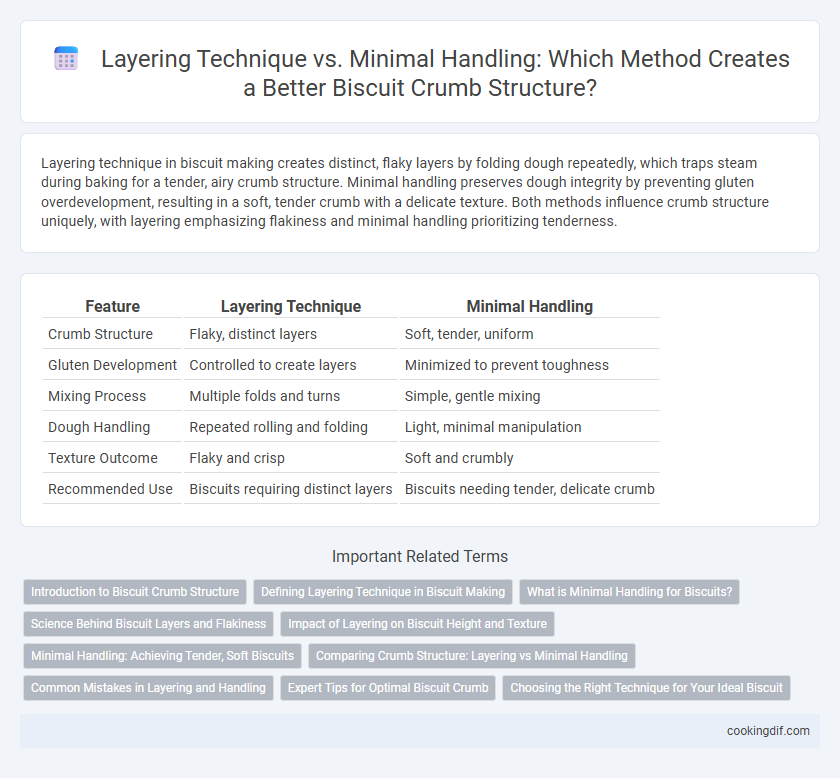Layering technique in biscuit making creates distinct, flaky layers by folding dough repeatedly, which traps steam during baking for a tender, airy crumb structure. Minimal handling preserves dough integrity by preventing gluten overdevelopment, resulting in a soft, tender crumb with a delicate texture. Both methods influence crumb structure uniquely, with layering emphasizing flakiness and minimal handling prioritizing tenderness.
Table of Comparison
| Feature | Layering Technique | Minimal Handling |
|---|---|---|
| Crumb Structure | Flaky, distinct layers | Soft, tender, uniform |
| Gluten Development | Controlled to create layers | Minimized to prevent toughness |
| Mixing Process | Multiple folds and turns | Simple, gentle mixing |
| Dough Handling | Repeated rolling and folding | Light, minimal manipulation |
| Texture Outcome | Flaky and crisp | Soft and crumbly |
| Recommended Use | Biscuits requiring distinct layers | Biscuits needing tender, delicate crumb |
Introduction to Biscuit Crumb Structure
Layering technique in biscuit making creates a flaky, distinct crumb structure by incorporating thin layers of fat and dough, producing a tender, airy texture. Minimal handling preserves gas bubbles and gluten network integrity, resulting in a soft, uniform crumb without dense patches. Understanding these methods is crucial for achieving the desired biscuit texture, whether flaky or tender.
Defining Layering Technique in Biscuit Making
Layering technique in biscuit making involves folding and rolling the dough multiple times to create distinct, flaky layers that enhance the crumb structure with crisp separations. This method promotes steam pockets during baking, resulting in a tender, airy texture characterized by visible stratification. Unlike minimal handling, which aims to preserve gluten for a softer crumb, layering deliberately develops folded layers to optimize flakiness and rise.
What is Minimal Handling for Biscuits?
Minimal handling for biscuits involves gently mixing the dough just until ingredients are combined, preserving the delicate balance between fat and flour to maintain a tender and flaky crumb structure. This technique prevents overworking the gluten, resulting in a softer texture with small, tender air pockets throughout the biscuit. Compared to layering, minimal handling emphasizes gentle incorporation rather than repeated folding, prioritizing subtle flakiness over pronounced layers.
Science Behind Biscuit Layers and Flakiness
Layering technique in biscuits creates distinct flaky layers by folding and rolling dough to trap steam during baking, which causes separation and lift in the crumb structure. Minimal handling promotes a tender crumb by limiting gluten development, resulting in a softer, less structured biscuit texture. Understanding the balance between layering for flakiness and minimal handling for tenderness is crucial in achieving the desired biscuit consistency.
Impact of Layering on Biscuit Height and Texture
Layering technique in biscuit making significantly enhances biscuit height and creates a flakier texture by incorporating distinct buttery layers throughout the dough. Minimal handling, while preserving dough temperature and gluten integrity, often results in denser biscuits with a tighter crumb. The impact of layering is particularly evident in the rise during baking, where trapped steam expands between layers, producing a light and airy crumb structure.
Minimal Handling: Achieving Tender, Soft Biscuits
Minimal handling of biscuit dough preserves gluten strands in a delicate network, resulting in a tender, soft crumb structure. This technique reduces overworking, preventing toughness and promoting a light, flaky texture. Consistently gentle folding and just enough incorporation of ingredients enhance biscuit crumb softness by maintaining optimal dough hydration and air pockets.
Comparing Crumb Structure: Layering vs Minimal Handling
Layering in biscuit dough creates distinct, flaky crumbs by folding butter or fat into the dough, which forms thin, separate layers during baking. Minimal handling results in a more tender, uniform crumb with a softer texture, as less gluten develops due to gentle mixing and limited manipulation. The layering technique favors a crisp, airy structure, while minimal handling produces a delicate, cake-like crumb.
Common Mistakes in Layering and Handling
Overworking biscuit dough in the layering technique often results in tough, dense crumbs due to gluten development, while insufficient folding can cause uneven layers and poor rise. Minimal handling prevents gluten overdevelopment but risks inadequate flakiness if the dough isn't folded enough to create pockets of steam. Common mistakes include excessive rolling that compresses air pockets and insufficient chilling, which both diminish the desired light, tender crumb structure.
Expert Tips for Optimal Biscuit Crumb
Layering technique in biscuit-making creates distinct, flaky layers by folding the dough multiple times, which traps air and produces a tender, flaky crumb. Minimal handling focuses on gently mixing ingredients just enough to combine, preventing gluten overdevelopment that leads to dense, tough biscuits. Expert tips for optimal biscuit crumb emphasize balancing layering for flakiness with minimal handling to maintain a soft, light interior texture.
Choosing the Right Technique for Your Ideal Biscuit
Choosing the right technique significantly impacts biscuit crumb structure; layering creates distinct, flaky layers by folding dough multiple times, trapping steam during baking for a light texture. Minimal handling preserves dough integrity, preventing gluten overdevelopment and yielding a tender, delicate crumb that is soft and tender. Understanding your desired biscuit texture guides whether to use layering for flakiness or minimal handling for softness, ensuring optimal results.
Layering technique vs Minimal handling for crumb structure Infographic

 cookingdif.com
cookingdif.com